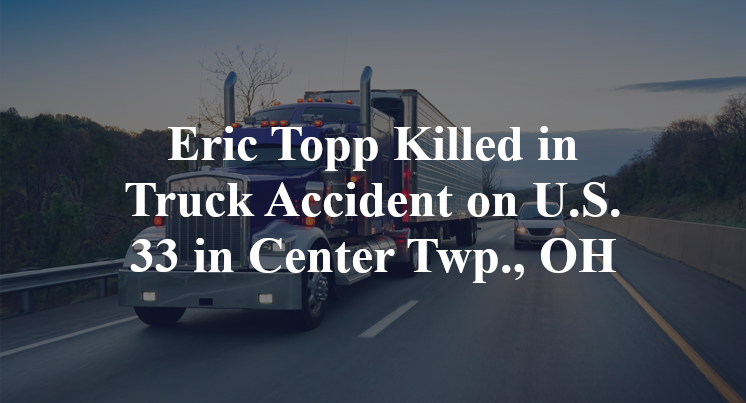Eric Topp Killed in Truck Accident on U.S. 33 in Center Twp., OH
UPDATE (May 12, 2025): Recent reports have been released which clarify some of the details in connection with this accident. According to these reports, 48-year-old Eric Topp was traveling in a southbound Cadillac on Celina Mendon Road approaching the U.S. 33 intersection. The Cadillac reportedly stopped at the stop sign at the intersection, but then continued into the intersection at an apparently unsafe time. The collision consequently took place between the Cadillac and an eastbound Peterbilt 18-wheeler that had been hauling a trailer. Investigations continue.
Mercer County, OH — May 10, 2025, Eric Topp was killed following a truck accident at approximately 3:00 p.m. along U.S. Highway 33.
According to authorities, the accident took place at the U.S. 33 and Celina Mendon Road intersection.

Details surrounding the accident remain scarce. Preliminary reports state that, for as yet unknown reasons, a collision took place between a passenger vehicle and an 18-wheeler. Officials indicate that 48-year-old Eric Topp suffered fatal injuries due to the accident and was declared deceased at the scene. Additional information pertaining to this incident is not available at this point in time. The investigation is currently ongoing.
Commentary
When a fatal crash at a rural intersection involves a passenger vehicle entering the path of an oncoming 18-wheeler, it’s easy to conclude that the driver of the smaller vehicle simply made a fatal misjudgment. But from a legal standpoint, intersection crashes like this one demand a deeper look—particularly when commercial trucks are involved. The core question becomes: Did the truck driver and their employer do everything they were supposed to do to prevent a foreseeable collision, even when another driver made a mistake?
According to updated reports, the Cadillac stopped at the stop sign on Celina Mendon Road before continuing into the path of an eastbound 18-wheeler on U.S. 33. At first glance, that may seem like an open-and-shut case of failure to yield. But that assumes everything on the truck’s side of the equation was in order. The law doesn’t just ask who had the right-of-way—it asks whether everyone involved was driving responsibly under the circumstances. For a commercial truck, that means operating at a safe speed, being alert for possible cross-traffic, and braking appropriately when a hazard appears.
One key issue is whether the truck was speeding or traveling too fast for conditions. U.S. 33 is a highway, but intersections like this one are known conflict points. Truck drivers operating on rural highways are expected to be extra cautious where cross traffic is controlled by stop signs. That means slowing down in anticipation of the possibility that someone might misjudge a gap—a known risk on these kinds of roads. If the truck was traveling too fast to avoid the Cadillac once it entered the intersection, that could factor into legal liability.
It’s also worth considering whether the truck driver had a clear line of sight and whether the intersection itself presented visibility challenges. Hills, curves, tree lines, or even poor signage can create a situation where a driver approaching a stop sign might believe the coast is clear when it's not. Those conditions don’t absolve the driver of the Cadillac from responsibility, but they can change the legal picture when evaluating the actions—or inactions—of a professional driver.
And because the 18-wheeler was hauling a trailer for commercial purposes, the trucking company must also be examined. Was the driver properly trained to approach rural intersections with caution? Was the truck equipped with functioning safety equipment like anti-lock brakes or collision mitigation systems? Did the company set delivery schedules or pressure drivers in ways that encouraged speeding or risky behavior? I’ve seen all of those issues play a role in crashes just like this one.
Getting to the bottom of a crash like this means asking the right questions and refusing to stop at surface-level explanations. Serious wrecks deserve serious investigation, not assumptions. Understanding whether the truck’s speed, visibility, or company policies contributed to the outcome is key to figuring out what might have happened. Getting clear answers to these questions is the least that can be done to help those affected find the clarity and closure they deserve.

“These are essential reads for anyone dealing with the aftermath of a truck wreck”– Attorney Cory Carlson